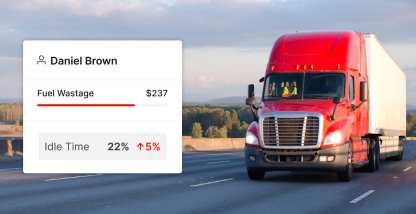Fuel-related expenditures represent a huge portion of a fleet’s overall expenses. According to a report by the American Transport Research Institute, fuel cost makes up 30 to 40 % of a fleet’s cost per mile.
Moreover, because of rising fuel prices, trucking companies, as well as owner-operators, often find it difficult to cut down fuel expenditures.
Statistics from the U.S. Bureau of Labor Statistics state that the prices for all types of gasoline have increased by a whopping 131.93 % from the year 2000 to 2022 — an average inflation rate of 3.90 % per year.
Just in the year between March 2021 and March 2022, fuel prices jumped up by 12.84% across the country, the highest rise since July 2008.
The rising fuel prices directly affect a carrier’s profitability and the company’s bottom line. Effectively managing fuel costs and minimizing expenditures, however, can help you improve the financial health of your business.
In this blog post, we share a few tips that carriers can use to minimize fuel expenditures and become more efficient and profitable.
1. Tracking excessive idling
It is estimated that for a truck that consumes $70,000 worth of fuel, approximately $5,600 is wasted on idling. By identifying drivers who idle for too long or too frequently, you can significantly reduce the amount of fuel you use every month.
The Motive ELD Pro has an idle-time tracking feature that allows you to track excessive idling across your fleet. You can identify drivers who idle frequently and start coaching them. With the Motive ELD Pro, you can also compare vehicle utilization rates across terminal or driver groups.
2. Vehicle maintenance
Vehicle maintenance issues may affect the performance of the vehicle and fuel efficiency. Low tire pressure, in particular, is a major cause of increased fuel consumption in motor vehicles.
Based on data from the U.S. Department of Energy, a reduction of 1 pound per square inch (PSI) in tire pressure reduces the fuel efficiency of vehicles by as much as 0.3 %.
The Motive ELD automatically monitors fault codes through its direct connection to on-board vehicle diagnostics. If an issue occurs, it is instantly displayed on the Motive Dashboard, and fleet managers receive a fault code notification.
By staying on top of vehicle health, you can improve fuel efficiency and reduce operational cost.
3. Limit speeding
Speeding is another driving behavior that can affect fuel efficiency. On average, increasing driving speed from 65 to 70 miles per hour will increase fuel consumption by 9%. Apart from poor fuel efficiency, speeding also increases the likelihood of road accidents.
By keeping an eye on the average speed, you can improve fuel efficiency and increase the safety of your fleet. Speeding may also promote unsafe driving practices, such as hard acceleration, hard cornering, and hard braking.
4. Optimizing routes
By planning the best possible routes, you can significantly reduce the amount of fuel your drivers use.
The Motive intuitive dashboard allows fleet managers to track your assets, optimize fleet operations, and plan effectively with real-time GPS and hours-of-service availability.
With proper planning and route optimization, fleets can improve fuel efficiency and reduce expenditures.
Improve fuel efficiency with Motive
The Motive ELD is not only FMCSA-registered, but it is also packed with powerful fleet management features that help you improve fuel efficiency, reduce administrative burden, minimize expenditures, and increase profitability.
With the latest technology, it is finally possible for fleets to improve fuel efficiency and stay profitable amid rising fuel prices.
Learn more about Motive and its different features.
If you want to experience firsthand how the Motive all-in-one fleet management solution can help your fleet become more efficient and productive, request a free demo.









